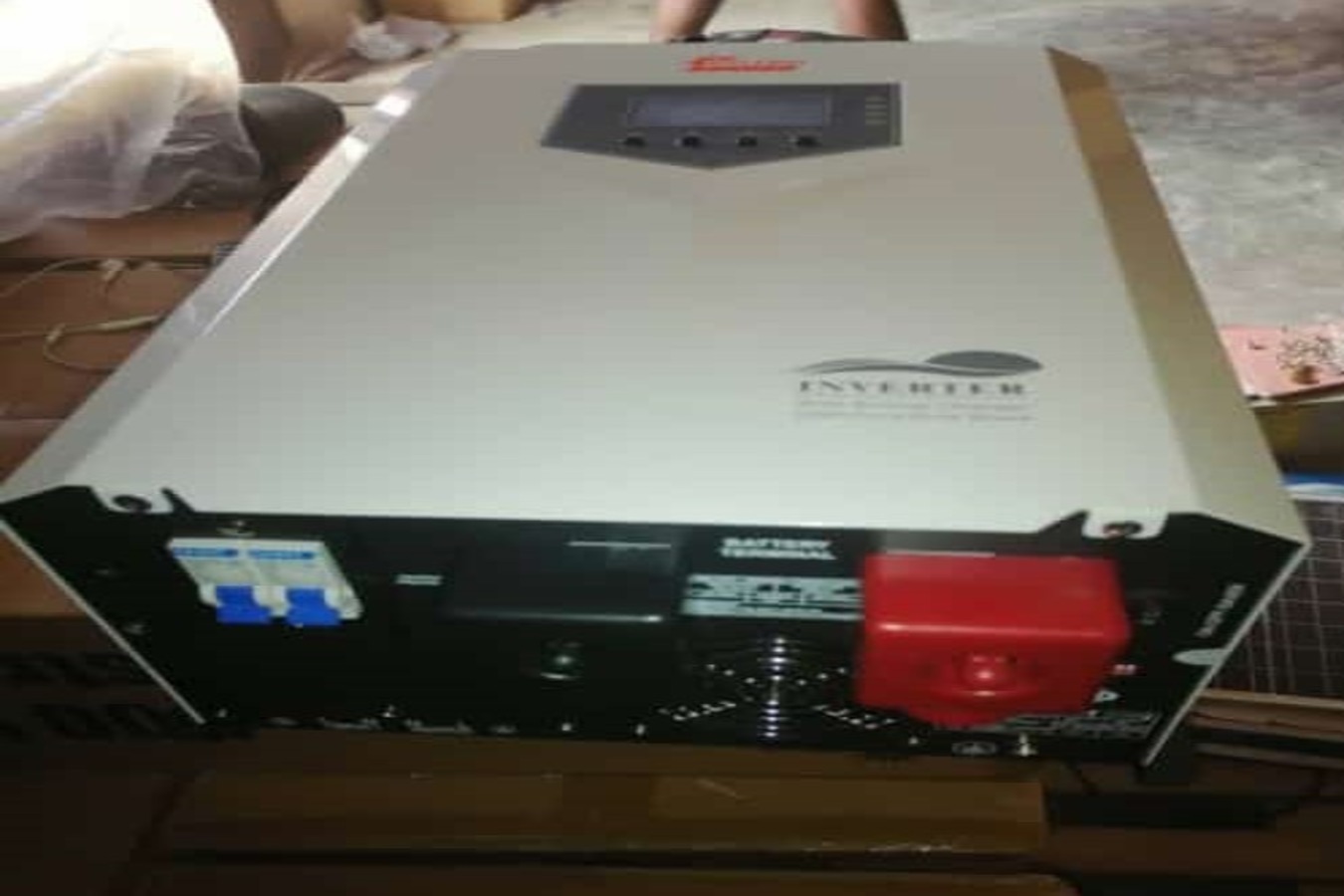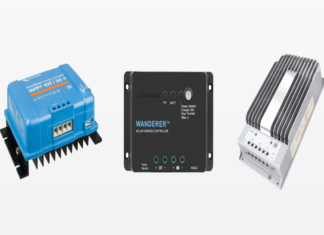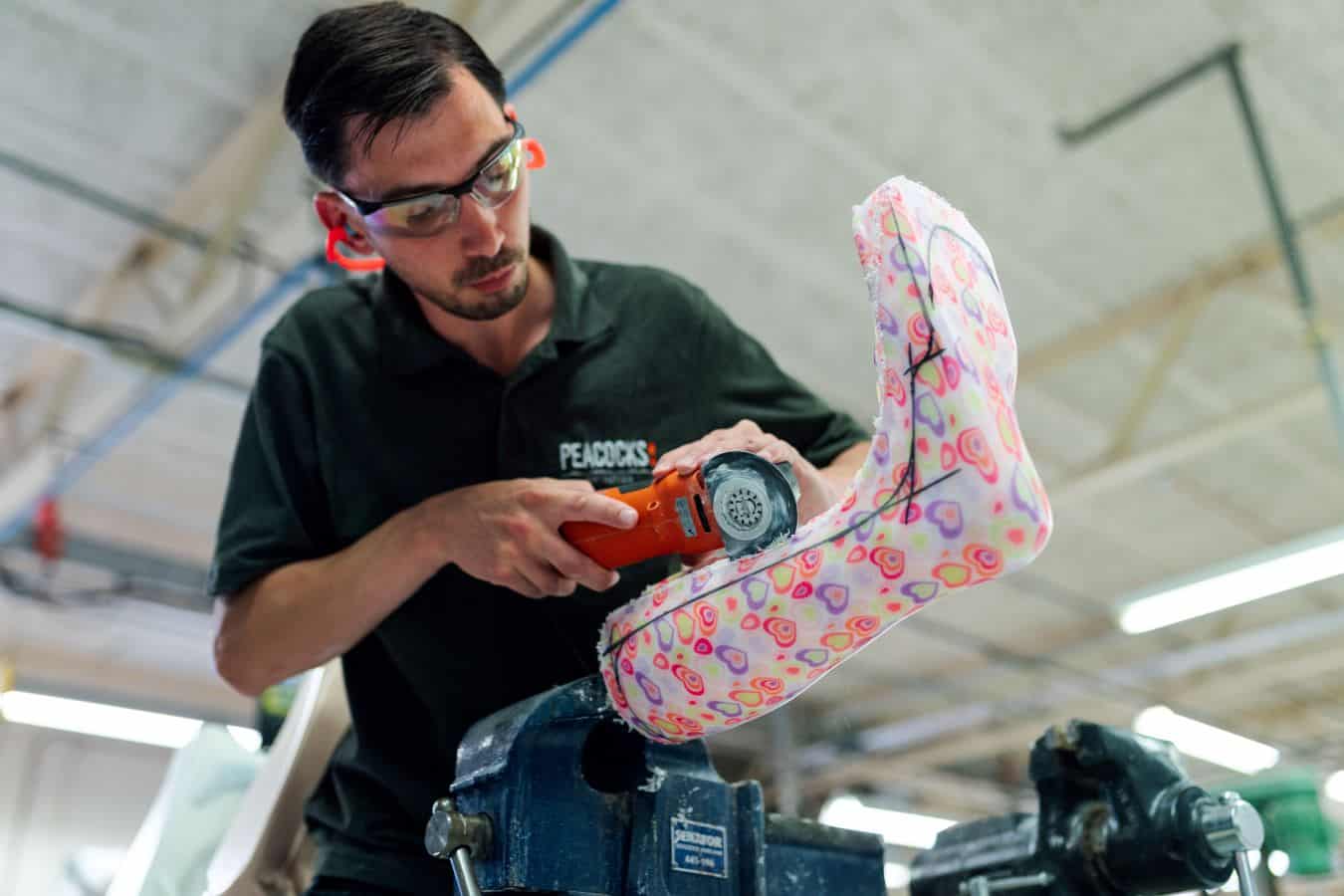Is your goal to utilize the financial benefits that come with solar energy? Then, it is important that you invest in the best solar grid-tie inverter of high quality.
As green energy gains more popularity, the demand for grid-tie inverters is on the rise. This is because a lot of people are acknowledging the benefits that come with connecting their solar system to their local electrical grid.
There is a wide range of solar grid-tie inverters that serve different solar panels and arrays. Choosing one will help significantly reduce the cost of your utility bills.
Moreover, it will reduce the amount of carbon footprint you leave behind by choosing eco-friendly solar energy.
However, you may have little or no knowledge about solar grid-tie inverters. Also, you may not know what the best options on the market are.
Then comes the purpose of this article— providing you with all the detailed information you need on the best solar grid-tie Inverter.
This article is divided into sections, for better clarity. The first section is an overview that is followed by an outline of some types of inverters for grid-tied solar power systems.
Then I will look at some factors to consider when choosing a solar grid-tie inverter. I will also discuss the pros and cons of the best solar grid-tie inverter.
The specifications of the best solar grid-tie inverter will be presented in a comparison table.
There will also be an extensive discussion on the 5 selected best Solar Grid-Tie to guide you in choosing the one that meets your need.
The frequently asked questions section will help clear whatever confusion you may have left, Endeavor not to skip this section.
Finally, I will be wrapping it up with my final thoughts section which will present a summary of the entire article.
The Best Solar Grid-Tie Inverter: Overview
Grid-tied solar systems are setups powered by solar energy and connected to the electricity grid. They function without a piece of backup battery equipment.
The sun cannot always supply power to solar systems, especially at night. This is why all grid-tied solar systems need a place to store the leftover generated energy.
Some people get a battery bank to store this energy, while others send the electricity into the utility grid, thereby, using the utility grid as a battery. Unlike other options, this costs nothing.
Grid-tie inverters convert the direct current (DC) into alternating current (AC). They also ensure that the voltage is suitable for the power grid, accurately matching the electrical system’s requirements to prevent overloading the distribution line.
The photovoltaic (PV) cells of the solar panels turn light into direct current (DC) electricity. This needs to be converted into alternating current (AC) before it can be used to run household appliances.
The grid-tie inverter manages the power from the solar panels so it is first sent to supply energy to the household before the excess is exported to the grid. They don’t require any batteries or other forms of energy storage to store solar power, making grid-tied solar systems cheaper and easier to install.
The functions of a grid-tie inverter can be simplified into two main parts: (a) the extraction of direct current (DC) from the solar panels and (b) the conversion of the extracted direct current (DC) into alternating current (AC) at a suitable voltage and frequency.
It functions like the brain of a solar system and manages the flow of power throughout the system, converting the captured direct current into usable alternating current power.
Types of Grid-Tie Inverters for Solar Systems
There are three main types of solar inverters for grid-tied solar systems, namely; micro, string, and central.
Micro Inverters
These inverters are made up of a small box found on the back of a solar panel. The function of a microinverter is to convert the direct current (DC) electricity produced by a single solar panel.
They are small weatherproof inverters that are suitable for solar systems in shaded areas. They also allow continuous power if one of the units is down and give room for expansions in the future.
The concept of a micro inverter is to pair an inverter with every panel, thereby, creating a self-contained single-panel solar system. Regardless of the number of panels, each will produce power.
If you intend to start with a small system and be able to expand over time, you may want to opt for this type of inverter. If you also want to independently monitor each panel, this is a great option.
Micro inverters make it easy to build your solar system at your own pace, although they cost more than other options. If you are on a budget and would rather build a complete system from the start, you may want to consider the most cost-effective option.
Advantages of Micro Inverters:
- Monitoring at the panel level
- A malfunctioning panel will not have a huge impact on the entire array, thereby increasing availability as there is no single point of failure.
- Lower DC voltage on this system increases safety
- Easy to use different models of modules in one system, especially when repairing or updating a system.
Disadvantages of Micro Inverters:
- Higher costs
- Complex installation
- May have issues in extreme heat situations
- The increased cost of maintenance due to the multiple units in an array
String Inverters
This inverter is commonly used in household and commercial solar systems.
A string inverter is a large box that is mostly found some distance away from the solar array, and the number of these inverters present depends on the size of the installation.
It is a single unit hooked into a string of solar panels. They are the least expensive option and do quite well under appropriate conditions.
Optimizers can also be paired with string inverters; this will help in solving shade problems. Adding optimizers to the panels is easy and effective when compared to replacing your whole inverter.
Advantages of String Inverters
- High efficiency
- Low cost
- Remote system monitoring
- High design flexibility
Disadvantages of String Inverters
- High voltage levels present a potential safety hazard
- No monitoring at the panel level
- Single point of failure. The entire solar system goes down if a string inverter goes out.
- Cannot be used for roof-mounted systems unless paired with a panel-level rapid shutdown device.
Central Inverters
These are used for large arrays installed on buildings, industrial facilities, and field installations. Basically, they are very large string inverters and are never used for residential applications.
They usually look like large metal plates, dealing with up to 500 kilowatts of power.
Advantages of Central Inverters
- High efficiency
- The comparative ease of installation
Disadvantages of Central Inverters
- Size
- Noise
Other types of grid-tie solar inverters are hybrids, battery inverters, and power-optimized inverters.
Hybrid inverters: these are also known as battery-based inverters that combine the grid-tie inverter technology with a battery inverter. Hybrid inverters convert direct current into alternating current for both solar panels and battery storage.
With hybrid inverters, a separate battery inverter is not a necessity for backup and even if the grid is down, you can rest assured knowing you will have backup power.
If you are looking for maximum design flexibility, increased monitoring capabilities, and lower maintenance, a hybrid inverter is your best bet.
Battery inverters: These are the best options for people who already have an inverter installed, but would like added energy storage without having to replace their solar systems with a hybrid inverter.
These inverters convert the stored power in the battery into usable alternating current (AC) and deliver the generated power via PV modules.
Power-optimized: They are also called PV inverters. Although more efficient, they are more expensive compared to string inverters.
These inverters are better suited for complex solar systems like those whose panels need to point in different directions. PV inverters are found at the back of each solar panel, just like micro inverters.
However, they do not convert the direct current (DC) electricity to alternating current (AC) electricity at the panel level. Instead, they optimize the direct current electricity before sending it to the central inverter.
Thus, the power output is improved, and there is a boost in the overall efficiency of the solar system.
Let us now look at some factors to consider when choosing a solar grid-tie inverter. These factors will serve as practical guides in helping you make an informed choice.
Factors to Consider when Choosing a Solar Grid-Tie Inverter
Having looked at the types of grid-tie inverters for solar systems there are, considering these factors will help you choose a product that will best serve your purpose. The following are the factors or things you want to look out for when choosing a solar grid-tie inverter:
Budget
The cost of an inverter depends on its type. The cost of micro inverters is commonly higher than that of string inverters.
Power optimizers are usually less expensive compared to micro inverters, and you don’t necessarily need to attach an optimizer to each panel. You may only attach optimizers to panels that require optimization.
The main point remains that whatever inverter you choose to get depends on how much you are willing to spend on an inverter that fits your needs and budget. Just bear in mind that some installations are more expensive than others.
Efficiency
This deals with how efficiently a solar inverter converts direct current (DC) into usable alternating current (AC) for household use or a power grid. This isn’t much of an issue, as modern inverters are highly efficient.
The only situations where you might want to check for efficiency, are in cases where you are comparing significant differences between two inverters that are quite similar.
Weatherproof
Most grid-tie inverters are weatherproof, but some are not, thereby requiring extra measures for weather protection. They may need special housing provisions for this.
Even if an inverter is weatherproof, it must be placed under a shade, as extreme heat and direct sunlight can reduce performance and durability. This is necessary as most inverters are located on external walls.
Durability
You can think of a solar inverter as a long-term investment, which is why it is essential that you check for and compare inverters based on their performance and durability.
I have already established the fact that some inverters are not suited for extreme weather conditions, which may lead to performance issues. Thus, it is important to go for an option that is resilient against these extreme conditions.
Identifying your Needs
Before purchasing a solar inverter, you need to identify your energy needs. This will help you choose a type of inverter that can generate as much energy as you need.
It is advisable to purchase an inverter that has the capacity to go beyond your energy needs, as there can be some energy loss in the system.
Brand
If you already have a brand in mind, you should carry out detailed research on it. Look out for opinions and reviews about the brand and its products.
This will greatly affect the decision you make in the end. Remember to go for a brand offering competitive prices and a warranty.
Dimensions
It is also important to take note of the physical dimensions of the inverter you are choosing. While micro-inverters are often sized like a normal paperback book, string inverters range in size between a big briefcase and a small suitcase.
Inverters are usually mounted in close proximity to the electric meters. Hence, with the physical dimension in mind, you would be able to consider how the inverter will look, mounted, and how close it can be placed to the meter.
Capacity
This is another important factor to note, as the capacity of the solar inverter you need, is very much on your solar system. The inverter’s capacity deals with how much-generated power the inverter can handle.
The optimal choice here is to get the maximum number of solar panels and an inverter that is able to manage the power output of your solar system.
Expandability
You need to consider this factor too if you plan to add panels to your existing solar system later. The best option is a multi-string inverter with MPPT trackers.
With a multi-MPPT inverter, there is no need to worry about finding the same panel model as the ones already installed.
Display
If the inverter you opt for has a display panel, you will be able to see how much power is being generated at the moment, for that day, and even during the entire lifetime of the inverter. It can show a lot of data.
The display light also indicates if the inverter is on. It can show you whether your inverter is running smoothly without any faults.
Remote Monitoring System
Some inverters come with a feature that allows remote monitoring. It can either be done using your smartphone or computer.
Choosing an inverter with this feature can be very convenient for you, especially if you don’t always want to walk to the inverter or meter to check on how it’s running.
However, most people completely forget about this feature, sometimes for months. If this is you, then, there is no need to overpay for an inverter with this feature when you are unsure you’re going to use it.
Power Outages
Most solar power systems turn off when there is a power outage. If you don’t want this to happen, then you may want to choose an inverter that allows the power to keep running, despite a power outage.
Inverters like this can be an expensive option. You will need a large solar system and a battery to keep the power running during several hours of a power outage.
Leaving only a few of the most important appliances running may, however, help in cutting down costs. Notwithstanding, the process would require additional electrical work, which will eventually lead to more expenses.
The Best Solar Grid-Tie Inverter: Pros and Cons
Pros
This is a brief rundown of the upsides of solar grid-tie inverters:
- Lowest Cost: This inverter doesn’t require a solar battery which is a good thing as solar batteries are quite expensive. Also, grid-tie inverters need less installation equipment and there’s less work for the installers, thereby lowering the cost of labor.
- More reliable than other PV options: grid-tie inverter has the fewest points of potential failure as it requires the least equipment.
Cons
The only notable downside of a solar grid-tie inverter is:
- No power during grid outages: because they do not have battery storage, grid-tie inverters do not provide backup power.
Specifications Of The Best Solar Grid-Tie Inverter
| Product Name | Dimensions | Item Weight | Wattage | Volts AC | Volts DC | Frequency |
| Y&H Grid Tie Inverter 600W | 12.2 x 8.8 x 4.9 inches | 4.1 pounds | 600W | 110V | 15-28V | 48Hz |
| EPREC 600W Grid Tie Solar Inverter | 15.71 x 8.23 x 4.41 inches | 5.36 pounds | 1000W | 90V-140V | 15-28V | |
| LiSos 1000w on Grid Tie Pure Sine Wave Power Inverter | 17.2 x 12.64 x 6.77 inches | 11.77 pounds | 1000W | 110V | 22 – 65V | |
| Y&H 1000W Grid Tie Inverter | 13 x 6 x 3 inches | 5.38 pounds | 1000W | 90V-140V | 30-45V | 48Hz |
| Y&H 2000W 2KW Grid Tie Inverter | 21.2 x 12.2 x 6.1 inches | 14.22 pounds | 2000W | 185-265V | 60-110V |
5Y&H Grid-Tie Inverter 600W
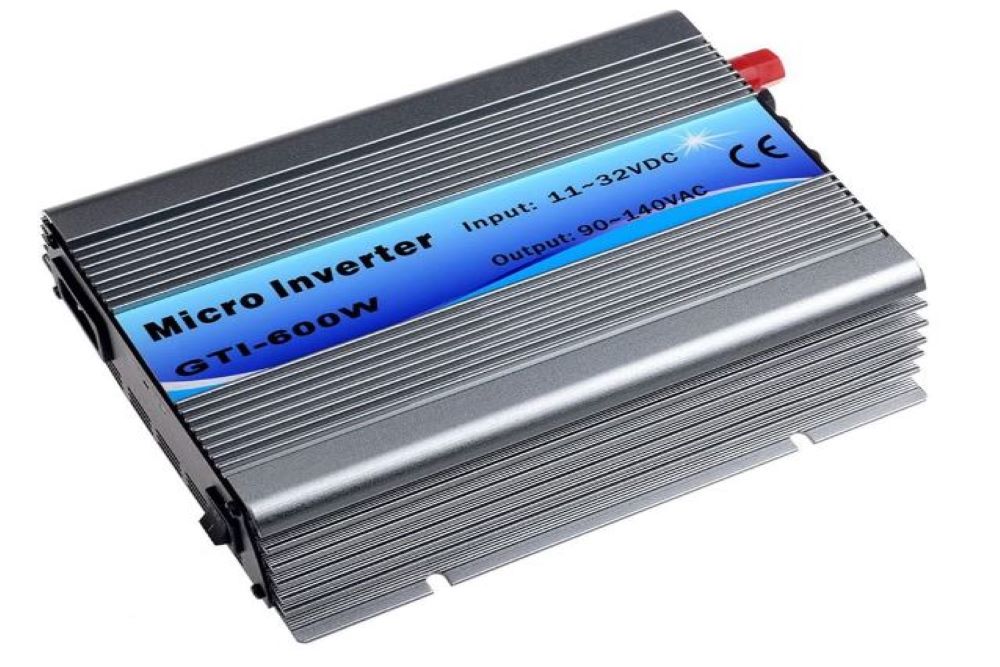
Making it to the list as number five is the Y&H Grid Tie Inverter 600W. It can power appliances that need 600W to run.
This inverter is a popular model that offers high power levels and is quite affordable. So if you are on a budget you may want to opt for this product.
The Y&H Grid Tie Inverter 600W is a great choice for homeowners looking for a budget-friendly option to power their basic household needs.
Pros
- Stackable
- MPPT power management
- Great over-temperature protection
Con
- Only functions with 24-volt batteries
4EPREC 600W Grid Tie Solar Inverter
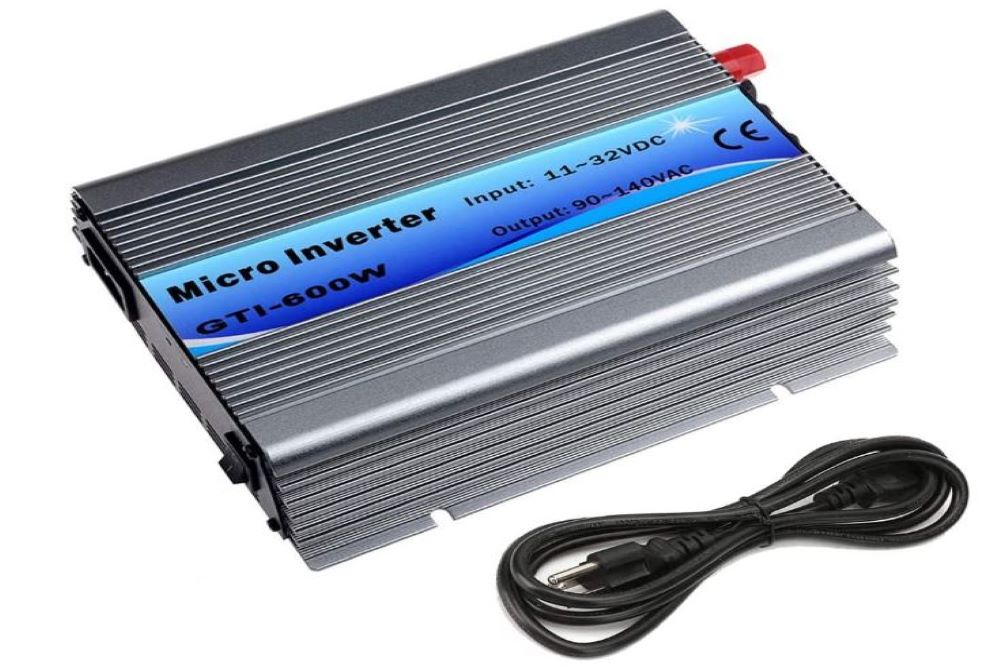
Number four on the list is the EPREC 6000W Grid Tie Solar Inverter. This inverter can be used to connect various sources like battery banks, solar panels, and wind turbines, to the grid.
It has a maximum power rating of 600W. This means that it is able to generate enough power needed to run small appliances like a refrigerator.
Pros
- Simple design
- Easy to install
- Quite light
Con
- It will not run with a 12-volt battery
3LiSos 1000w on Grid Tie Pure Sine Wave Power Inverter
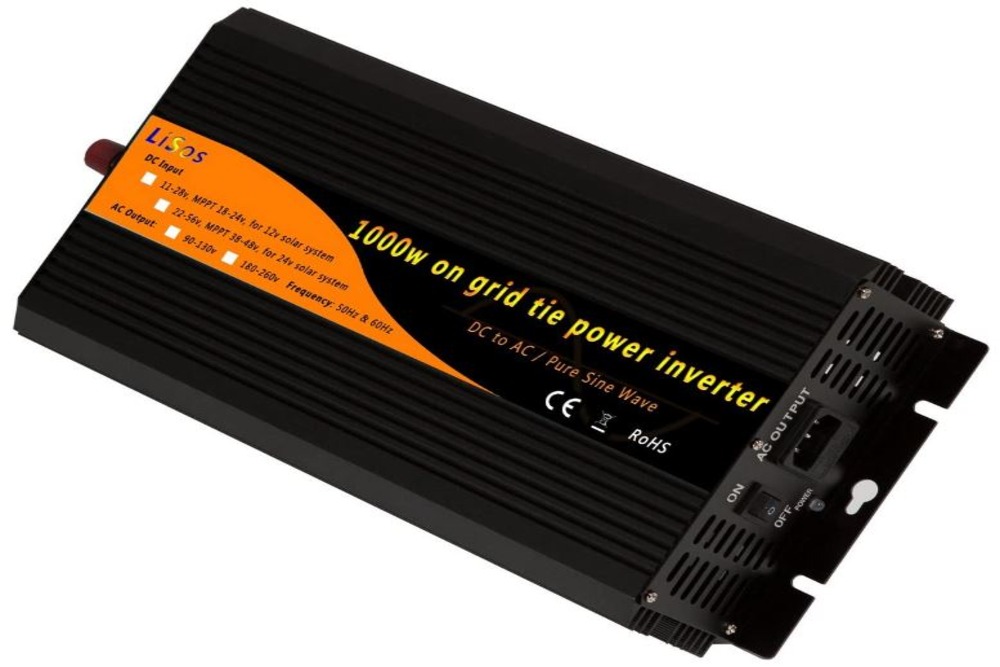
Taking the number three spot on the list is the LiSos 1000W on-grid power inverter. This inverter was designed for 12v solar systems, so ensure that your DC output voltage is within the inverter’s DC range.
The inverter has a multi-protection function that guarantees over-current protection as well as over-temperature protection, among others. There is also an automatic sensing function, which means your system will restart automatically every morning.
This inverter promises better cooling functions as it is built with both a fan and an aluminum shell. There’s also the LED light feature that shows you the different working status of the inverter.
Pros
- Stackable
- Maximum power point tracking
- Multi-protection function
- Easy to install
- Easy to carry and handle
Con
- May require an adapter as outlets and voltage differ internationally
2Y&H 1000W Grid Tie Inverter
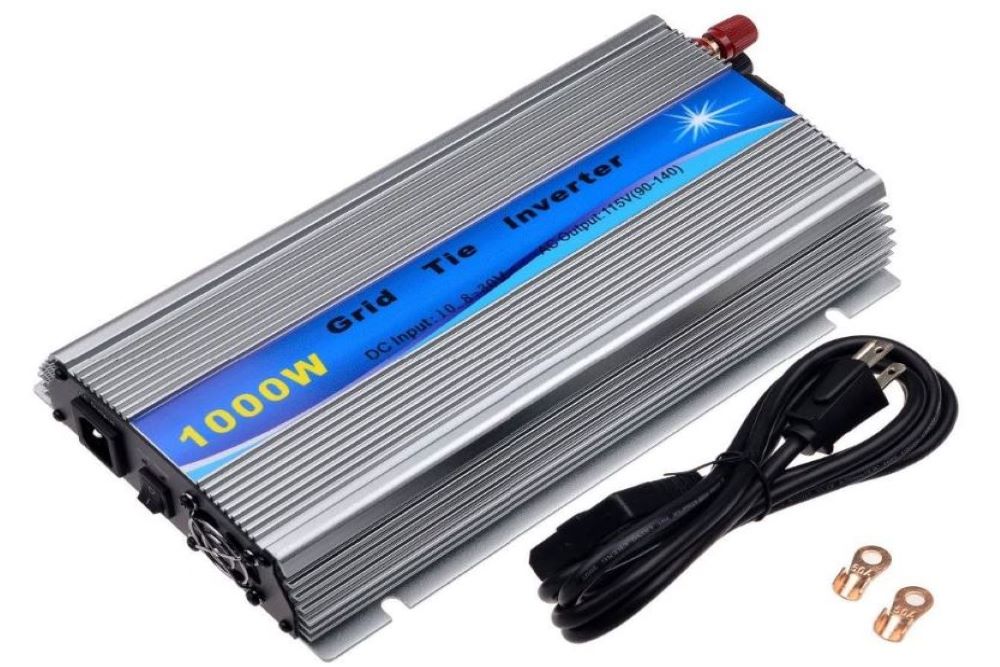
Number two on our list is the Y&H 1000W Grid-Tie Inverter, a compact unit that directly converts direct current (DC) into alternating current (AC) for powering household appliances and connecting to the utility grid.
This solar inverter has a power limiter sensor. This means the inverter only delivers the power needed thereby, prevents the delivery of excess power back to the grid.
In addition to the PV power generation mode, there is a battery energy storage grid-tie power generation mode. The excess electricity the solar panels generate during the day is stored in the battery.
This grid-tie inverter is suitable for solar panels having at least a minimum power of 200W and a maximum power of 1100W. Ensure the power of your solar panel falls within this range.
It has an LCD that shows the current state of the solar panel and can set the photovoltaic/battery mode. The creative MPPT technology makes efficiency higher than 99%
This inverter is also equipped with high-speed ventilation fans to help keep the inverter at a low temperature.
Pros
- MPPT range between 15.5 – 23V
- Frequency range 48Hz – 62Hz
- Stackable connection
- Multiple protections
Con
- Gets hot quickly
1Y&H 2000W 2KW Grid Tie Inverter

Taking the number one spot on the list is the Y&H 2000W 2KW Grid-Tie Inverter. This inverter promises low power consumption, over-temperature protection, anti-island protection, and reverse polarity protection.
The MPPT function improves the efficiency of the entire solar system as every panel is able to work maximally. It can be used as a separate grid tie system and can be set up as a large solar array.
It also carries a limiter sensor that manages the amount of power being distributed. All adjustable parameters and the status of the inverter are shown on the big LCD.
Pros
- Limiter sensor
- Stackable
- MPPT technology
Cons
- May struggle in low-light environments
- May heat up
Frequently Asked Questions On The Best Solar Grid-Tie Inverter
By converting direct current (DC) captured by PV modules into alternating current (AC). Most household appliances run on this alternating current thereby, making an inverter necessary.
An inverter helps utilize the energy produced by solar panels.
No. Their main function is to convert the direct current into an alternating current. They also have many other benefits.
The standard output is between 450W – 500W.
First, you need to ask yourself what model of the inverter will fit your application. Also, what inverters will meet your needs?
A grid-tie inverter must be able to adjust the current draw. It must also be able to deliver the most energy possible while being low on weight and space.
The solar panels gather sunlight and convert it to Electricity (direct current). Direct current (DC) is converted to alternating current via the inverter (AC).
A switchboard will be powered by solar energy during the day to power appliances.
Grid-tied systems use the electrical grid to store energy.
My Final Thoughts On The Best Solar Grid-Tie Inverter
Investing in a solar grid tie inverter can help reduce your monthly utility bills and turn your solar array into a profitable source of energy. It gives you the option to power your home with clean solar electricity.
This post should have clarified any areas of confusion you may have had at first. If you’ve decided to buy a solar grid-tie inverter, the products listed in this article are indeed a great place to start.
I hope you found this buying guide helpful.
Kindly share your thoughts with us by filling out the “Leave A Reply” form at the end of this page.
References And Further Reading
solarreviews.com – Grid-tied solar systems explained
list.solar – How to Choose a Solar Inverter
5 Best Inverter Generators: Easy For Camping
What Is An Inverter Generator: Easy Decision – Inverter or Generator

